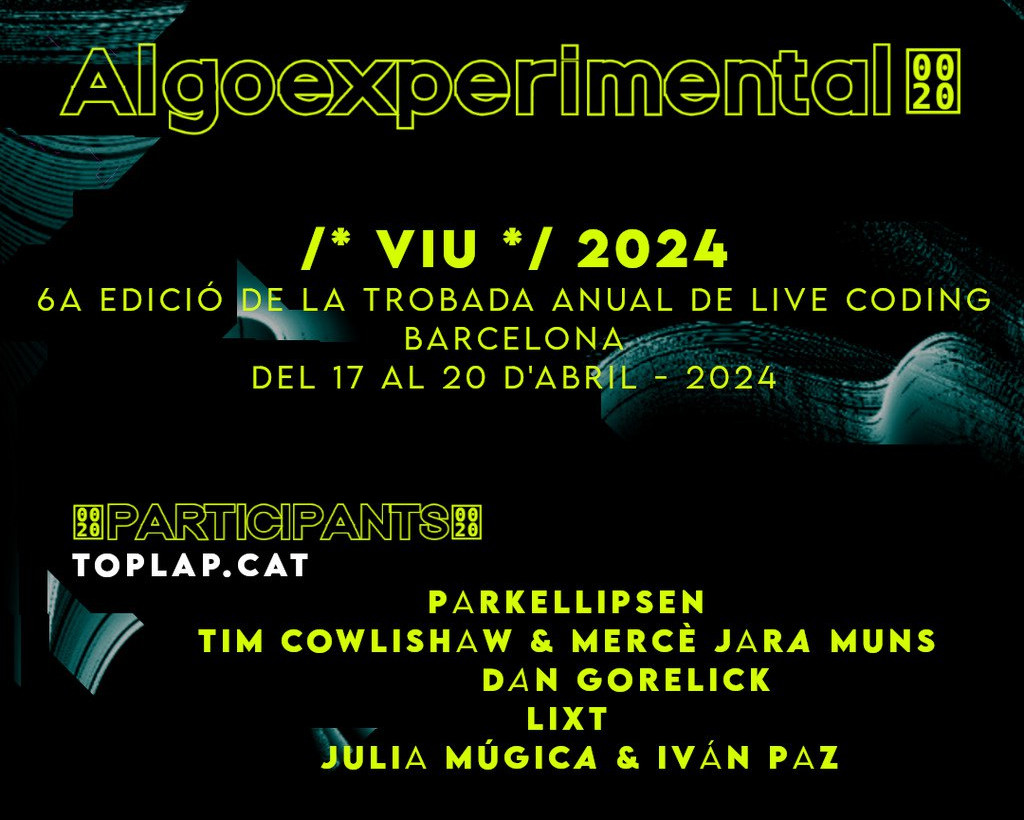Algo Experimental - VIU Festival 2024
Friday, April 19th, 2024 at 19h. Sala Aranyó: Roc Boronat 138, Barcelona (UPF Campus Poblenou). Free entry

Phonos collaborates in the sixth edition of the VIU Festival, an international live coding meeting in Barcelona, which will take place from April 17 to 20, 2024 at different venues.
On April 19th, we host the Algo Experimental concert in Sala Aranyó. Featuring a wide range of live coding possibilities reflected on musical practices as contrasting as the technical tools creating them. Ranging from electrical noise to algorithmic pattern melodies this concert will take us to that space when patch programming and high-level abstractions are used for real-time human-machine interaction using code for performing arts.
Program:
Lixt (Rafael Bresciani)
[sh[i]e[l]d]
lixt is Rafael Bresciani's research on the use of live coding as an artistic expression. In the historical moment in which human experience is massively mediated by digital environments, Bresciani – journalist, musician and master in NetArt and Digital Culture – investigates the crisis of language, contrasting the thinking of Wittgenstein and Flusser with the aesthetics and structure of contemporary society.
Dan Gorelick
Resonance Reverie: A Cybernetic Somatic Ritual
"Resonance Reverie: A Cybernetic Somatic Ritual" is an immersive audio-visual piece that invites the audience to join in for a collective moment of pause to ground, presence, and reflect. The piece incorporates live coding practices with learnings from playing music in sound healing contexts, such as binaural beats and using the somatic nature of subsonic frequencies. Using the cello, gesture-based granular synthesis, and the acoustics of the space itself, the piece explores how sound can create different somatic sensations.
Julia Múgica & Iván Paz
In this experiment, we will explore the synchronization of oscillators that are initially out-of-phase by adjusting their oscillation frequencies with other oscillators that are connected in a dynamical network. By live coding the parameters of a synchronization model, we'll play with the synchronization process in real-time, visualizing the oscillators as we change their parameters and simultaneously sonifying their frequencies in a multichannel setup. This configuration will allow us to experience the periodicity of each oscillator and the transition of the system from asynchronous to various synchronization patterns.
Tim Cowlishaw & Mercè Jara Muns
Stones Whisper Secrets
A collaboration between Tim Cowlishaw (algorithms, codes, cables) and Mercè Jara Muns (clay, air, water), Stones Whisper Secrets is a sonic reflection on the vibrant materiality of computation, and its links to the earth that gave birth to it. Silicon dialogues with clay, copper with ceramics. We both work with terrestrial and geological matter - Mercè with the latent resonances of mud and clay, and Tim with the activation of silicon and foreign earths through computation.
In this performance, we bring together these two ways of approaching the earth as a sonic instrument - Mercè generating sound with the strokes, touches and caresses of the hand on the ceramic, processed and manipulated by Tim through electronics and livecode techniques, generating an immersive sound field from Mercè's raw material. In this way, we open a space for meditation on the multiple ways in which materiality is involved in musical creation through electronics.
parkellipsen (Niklas Reppel)
A Glass Jar and a Terracotta Pot (and Plenty of Room)
This fairly minimalist piece is based on only two percussive, found sounds (plus some pitch shifting, and some accidentally recorded birds in the background). It is the result of my more in-depth explorations of Mégra's Markov chain learning algorithm, its parameters, and their impact on the musical result.
I'll explore the spatial distribution of the sounds as a fundamental parameter, learned in near real-time from patterns (here: sequences of characters) and modified through the manipulation of said patterns and other parameters of the algorithm (i.e. the memory length), to spread out the dense, polyrhythmic textures into wide, open clouds of percussive tones.
The learned Markov chains not only define the structure of the piece, but also have a certain beauty in their visual representation, which will be shown both as a visualization of, and a guide to, the performance.
More information: https://toplap.cat/posts/viu-2024-algoexp/
In collaboration with: Toplap BCN, Axolot.cat

Supported by:

